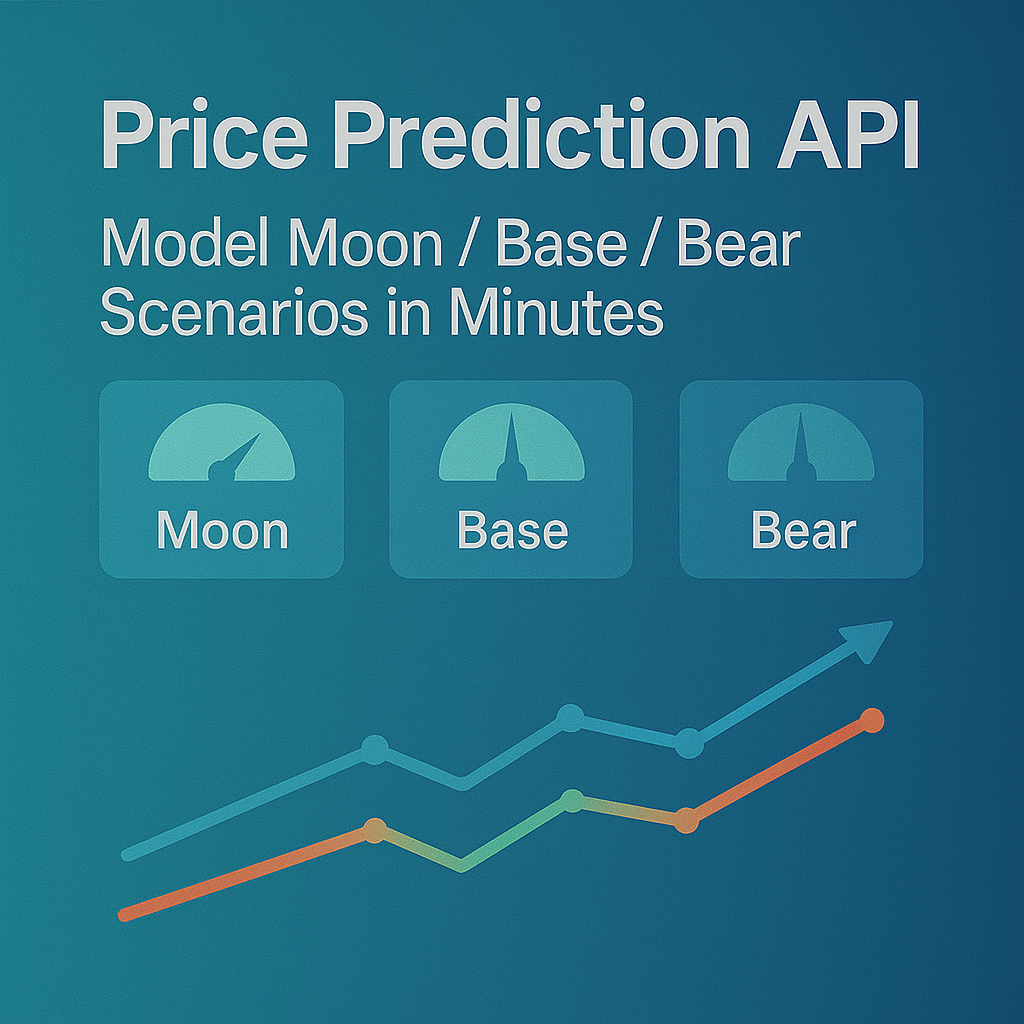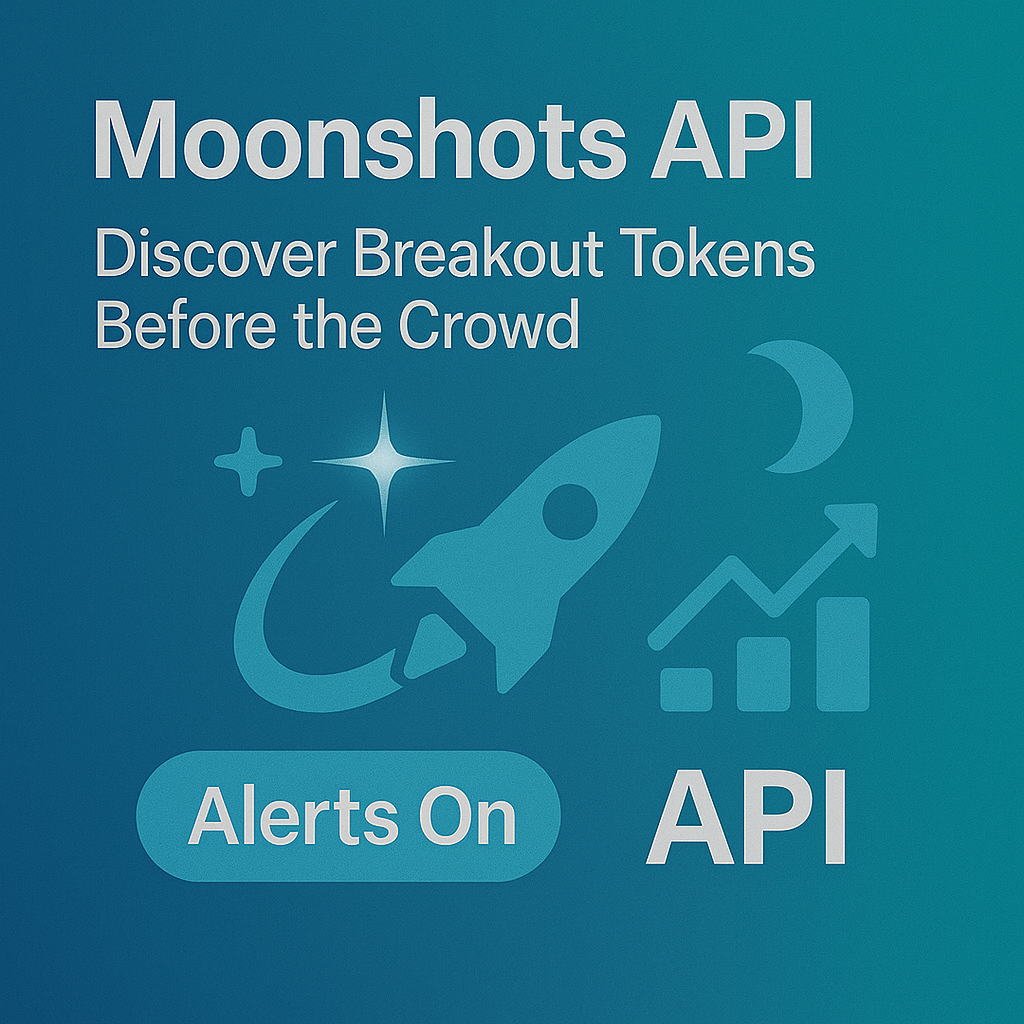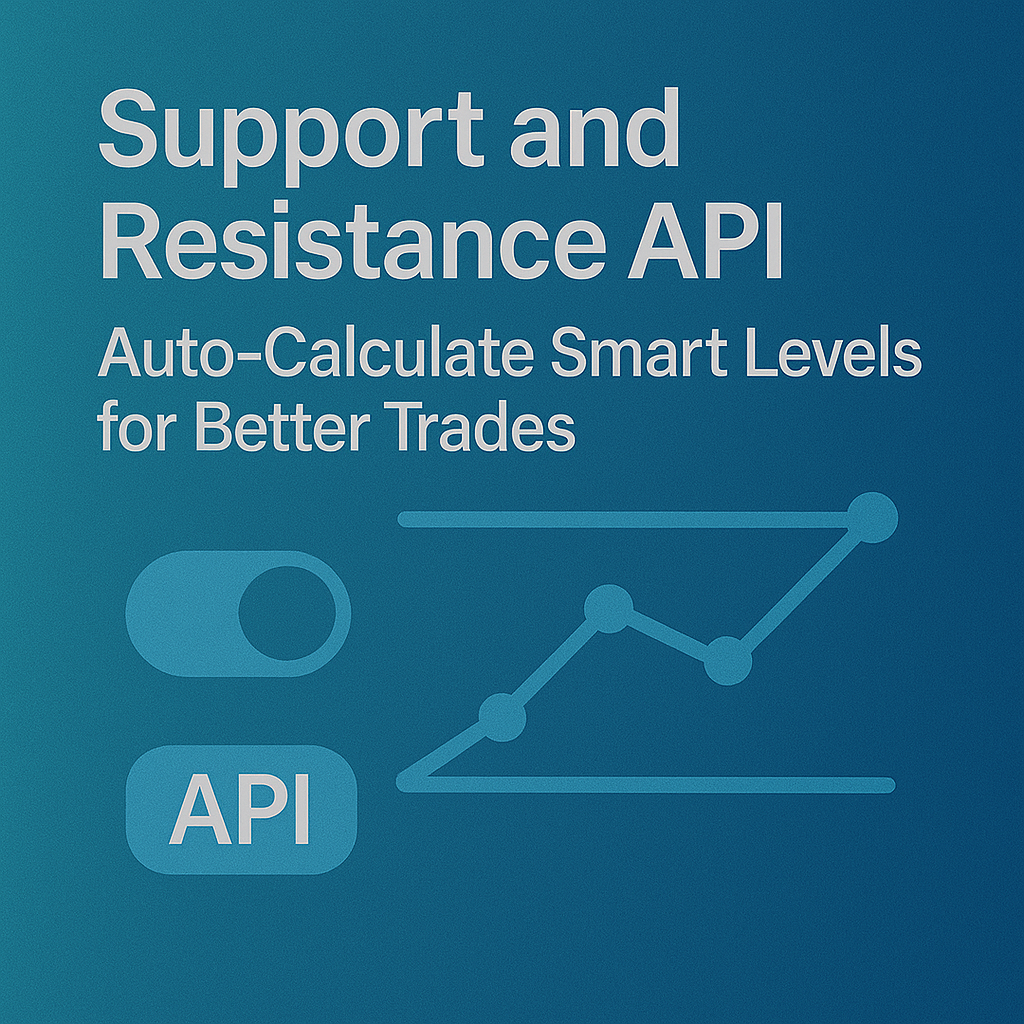Top Crypto Trading Platforms in 2025







%201.svg)
%201.svg)
Big news: We’re cranking up the heat on AI-driven crypto analytics with the launch of the Token Metrics API and our official SDK (Software Development Kit). This isn’t just an upgrade – it's a quantum leap, giving traders, hedge funds, developers, and institutions direct access to cutting-edge market intelligence, trading signals, and predictive analytics.
Crypto markets move fast, and having real-time, AI-powered insights can be the difference between catching the next big trend or getting left behind. Until now, traders and quants have been wrestling with scattered data, delayed reporting, and a lack of truly predictive analytics. Not anymore.
The Token Metrics API delivers 32+ high-performance endpoints packed with powerful AI-driven insights right into your lap, including:
Getting started with the Token Metrics API is simple:
At Token Metrics, we believe data should be decentralized, predictive, and actionable.
The Token Metrics API & SDK bring next-gen AI-powered crypto intelligence to anyone looking to trade smarter, build better, and stay ahead of the curve. With our official SDK, developers can plug these insights into their own trading bots, dashboards, and research tools – no need to reinvent the wheel.
%201.svg)
%201.svg)
The biggest gains in crypto rarely come from the majors. They come from Moonshots—fast-moving tokens with breakout potential. The Moonshots API surfaces these candidates programmatically so you can rank, alert, and act inside your product. In this guide, you’ll call /v2/moonshots, display a high-signal list with TM Grade and Bullish tags, and wire it into bots, dashboards, or screeners in minutes. Start by grabbing your key at Get API Key, then Run Hello-TM and Clone a Template to ship fast.
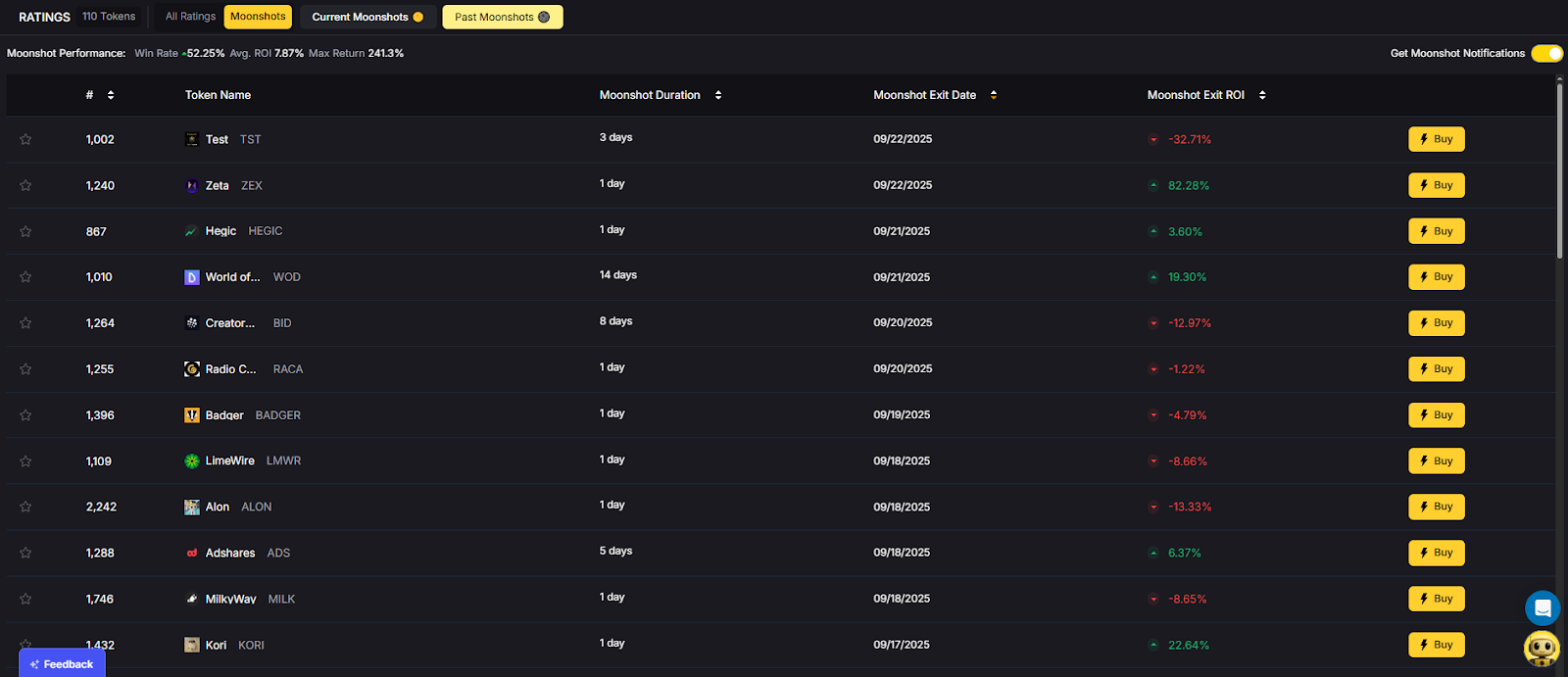
Discovery that converts. Users want more than price tickers—they want a curated, explainable list of high-potential tokens. The moonshots API encapsulates multiple signals into a short list designed for exploration, alerts, and watchlists you can monetize.
Built for builders. The endpoint returns a consistent schema with grade, signal, and context so you can immediately sort, badge, and trigger workflows. With predictable latency and clear filters, you can scale to dashboards, mobile apps, and headless bots without reinventing the discovery pipeline.
The Moonshots API cURL request is right there in the top right of the API Reference. Grab it and start tapping into the potential!
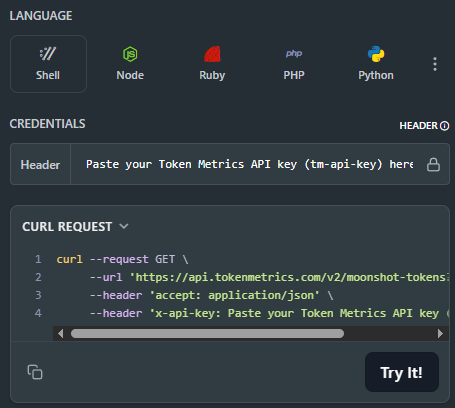
👉 Keep momentum: Get API Key • Run Hello-TM • Clone a Template
Fork a screener or alerting template, plug your key, and deploy. Validate your environment with Hello-TM. When you scale users or need higher limits, compare API plans.
The Moonshots endpoint aggregates a set of evidence—often combining TM Grade, signal state, and momentum/volume context—into a shortlist of breakout candidates. Each row includes a symbol, grade, signal, and timestamp, plus optional reason tags for transparency.
For UX, a common pattern is: headline list → token detail where you render TM Grade (quality), Trading Signals (timing), Support/Resistance (risk placement), Quantmetrics (risk-adjusted performance), and Price Prediction scenarios. This lets users understand why a token was flagged and how to act with risk controls.
Polling vs webhooks. Dashboards typically poll with short-TTL caching. Alerting flows use scheduled jobs or webhooks (where available) to smooth traffic and avoid duplicates. Always make notifications idempotent.
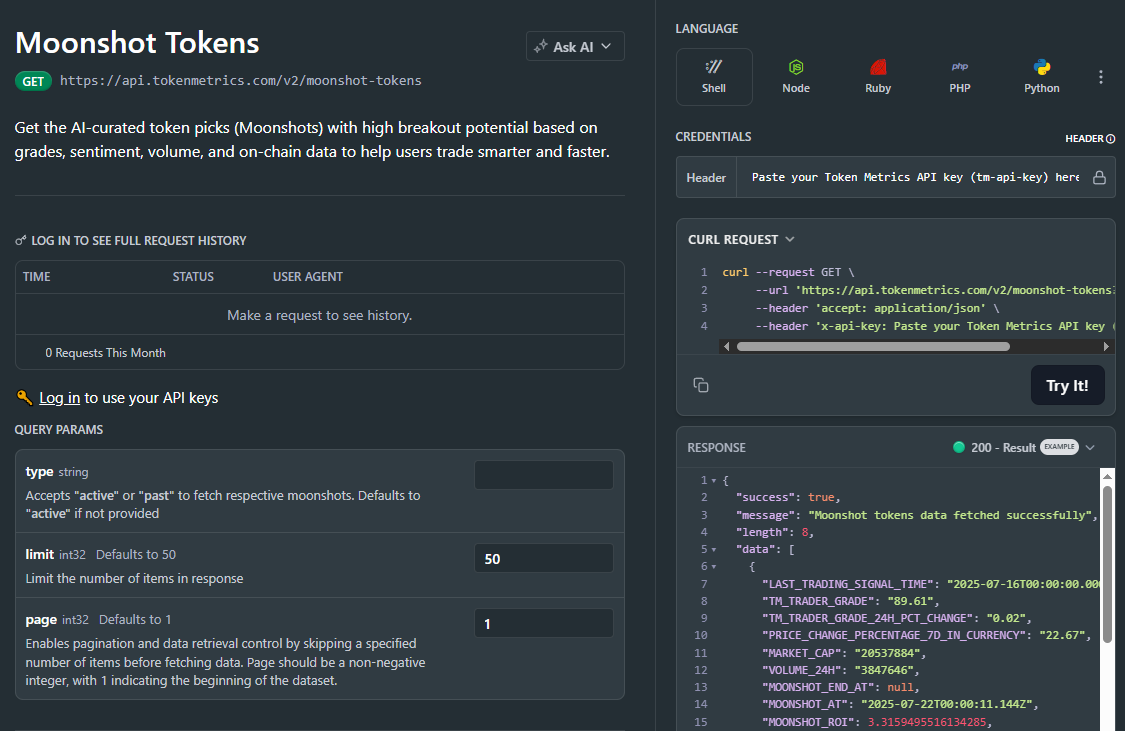
1) What does the Moonshots API return?
A list of breakout candidates with fields such as symbol, tm_grade, signal (often Bullish/Bearish), optional reason tags, and updated_at. Use it to drive discover tabs, alerts, and watchlists.
2) How fresh is the list? What about latency/SLOs?
The endpoint targets predictable latency and timely updates for dashboards and alerts. Use short-TTL caching and queued jobs/webhooks to avoid bursty polling.
3) How do I use Moonshots in a trading workflow?
Common stack: Moonshots for discovery, Trading Signals for timing, Support/Resistance for SL/TP, Quantmetrics for sizing, and Price Prediction for scenario context. Always backtest and paper-trade first.
4) I saw results like “+241%” and a “7.5% average return.” Are these guaranteed?
No. Any historical results are illustrative and not guarantees of future performance. Markets are risky; use risk management and testing.
5) Can I filter the Moonshots list?
Yes—pass parameters like min_grade, signal, and limit (as supported) to tailor to your audience and keep pages fast.
6) Do you provide SDKs or examples?
REST works with JavaScript and Python snippets above. Docs include quickstarts, Postman collections, and templates—start with Run Hello-TM.
7) Pricing, limits, and enterprise SLAs?
Begin free and scale up. See API plans for rate limits and enterprise options.
%201.svg)
%201.svg)
Most traders still draw lines by hand in TradingView. The support and resistance API from Token Metrics auto-calculates clean support and resistance levels from one request, so your dashboard, bot, or alerts can react instantly. In minutes, you’ll call /v2/resistance-support, render actionable levels for any token, and wire them into stops, targets, or notifications. Start by grabbing your key on Get API Key, then Run Hello-TM and Clone a Template to ship a production-ready feature fast.
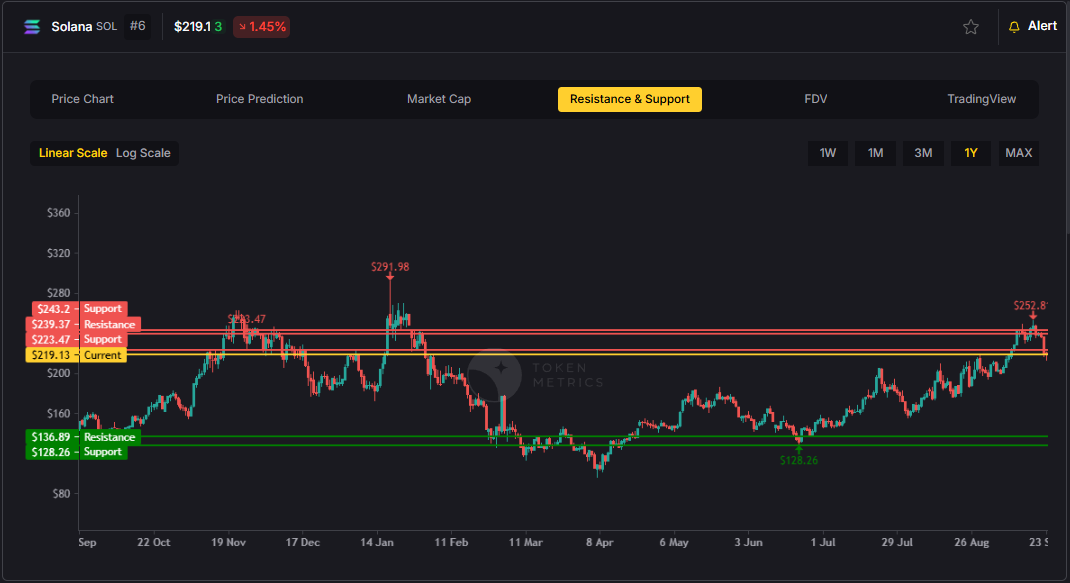
Precision beats guesswork. Hand-drawn lines are subjective and slow. The support and resistance API standardizes levels across assets and timeframes, enabling deterministic stops and take-profits your users (and bots) can trust.
Production-ready by design. A simple REST shape, predictable latency, and clear semantics let you add levels to token pages, automate SL/TP alerts, and build rule-based execution with minimal glue code.
Need the Support and Resistance data? The cURL request for it is in the top right of the API Reference for quick access.
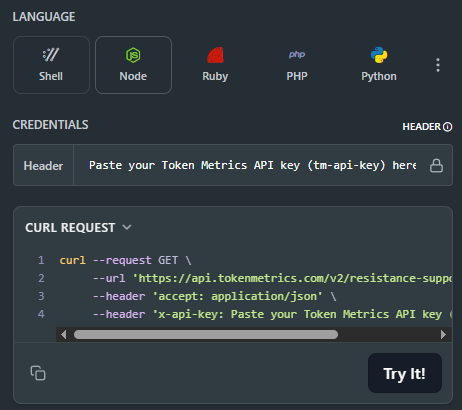
👉 Keep momentum: Get API Key • Run Hello-TM • Clone a Template
Kick off with our quickstarts—fork a bot or dashboard template, plug your key, and deploy. Confirm your environment by Running Hello-TM. When you’re scaling or need webhooks/limits, review API plans.
The Support/Resistance endpoint analyzes recent price structure to produce discrete levels above and below current price, along with strength indicators you can use for priority and styling. Query /v2/resistance-support?symbol=<ASSET>&timeframe=<HORIZON> to receive arrays of level objects and timestamps.
Polling vs webhooks. For dashboards, short-TTL caching and batched fetches keep pages snappy. For bots and alerts, use queued jobs or webhooks (where applicable) to avoid noisy, bursty polling—especially around market opens and major events.
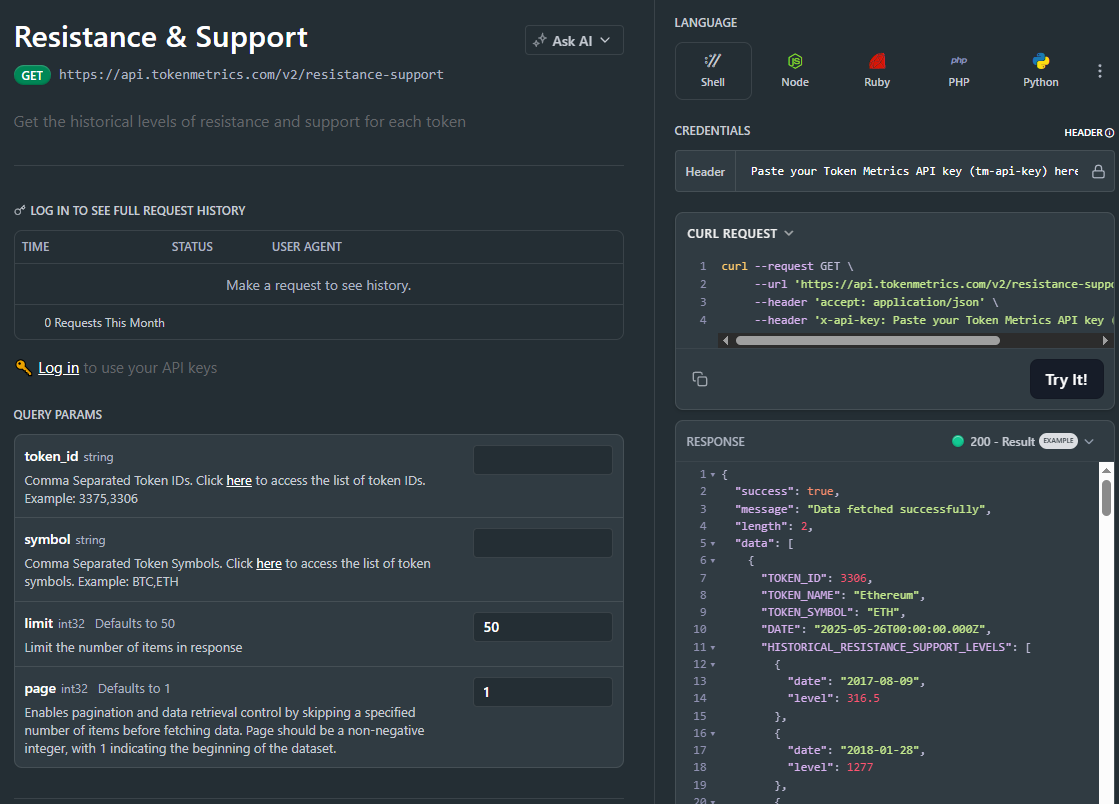
1) What does the Support & Resistance API return?
A JSON payload with arrays of support and resistance levels for a symbol (and optional timeframe), each with a price and strength indicator, plus an update timestamp.
2) How timely are the levels? What are the latency/SLOs?
The endpoint targets predictable latency suitable for dashboards and alerts. Use short-TTL caching for UIs, and queued jobs or webhooks for alerting to smooth traffic.
3) How do I trigger alerts or trades from levels?
Common patterns: alert when price is within X% of a level, touches a level, or breaks beyond with confirmation. Always make downstream actions idempotent and respect rate limits.
4) Can I combine levels with other endpoints?
Yes—pair with /v2/trading-signals for timing, /v2/tm-grade for quality context, and /v2/quantmetrics for risk sizing. This yields a complete decide-plan-execute loop.
5) Which timeframe should I use?
Intraday bots prefer shorter horizons; swing/position dashboards use daily or higher-timeframe levels. Offer a timeframe toggle and cache results per setting.
6) Do you provide SDKs or examples?
Use the REST snippets above (JS/Python). The docs include quickstarts, Postman collections, and templates—start with Run Hello-TM.
7) Pricing, limits, and enterprise SLAs?
Begin free and scale as you grow. See API plans for rate limits and enterprise SLA options.
%201.svg)
%201.svg)
Most traders see price—quants see probabilities. The Quantmetrics API turns raw performance into risk-adjusted stats like Sharpe, Sortino, volatility, drawdown, and CAGR so you can compare tokens objectively and build smarter bots and dashboards. In minutes, you’ll query /v2/quantmetrics, render a clear performance snapshot, and ship a feature that customers trust. Start by grabbing your key at Get API Key, Run Hello-TM to verify your first call, then Clone a Template to go live fast.
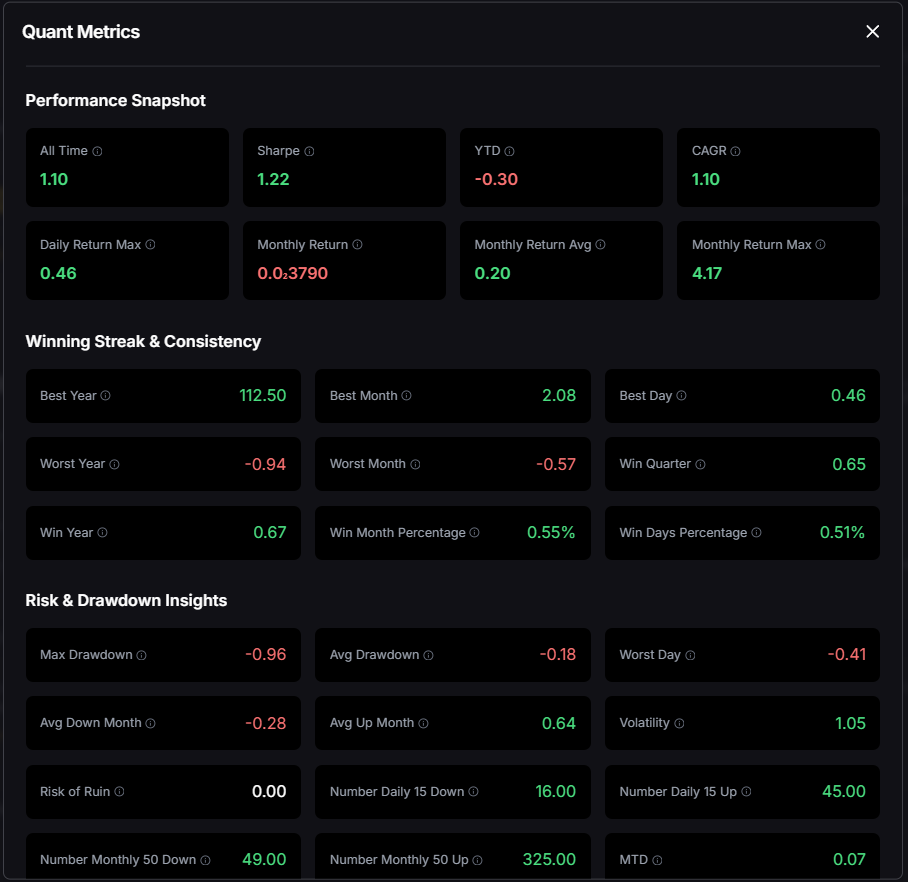
Risk-adjusted truth beats hype. Price alone hides tail risk and whipsaws. Quantmetrics compresses edge, risk, and consistency into metrics that travel across assets and timeframes—so you can rank universes, size positions, and communicate performance like a pro.
Built for dev speed. A clean REST schema, predictable latency, and easy auth mean you can plug Sharpe/Sortino into bots, dashboards, and screeners without maintaining your own analytics pipeline. Pair with caching and batching to serve fast pages at scale.
The Quant Metrics cURL request is located in the top right of the API Reference, allowing you to easily integrate it with your application.
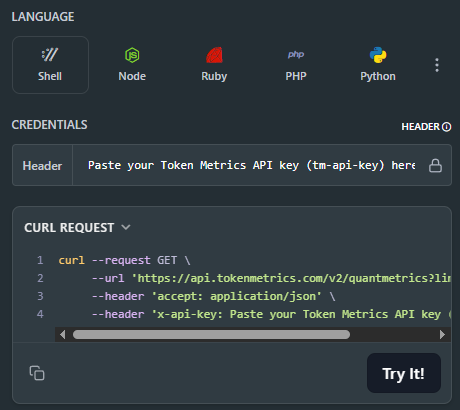
👉 Keep momentum: Get API Key • Run Hello-TM • Clone a Template
Kick off from quickstarts in the docs—fork a dashboard or screener template, plug your key, and deploy in minutes. Validate your environment with Run Hello-TM; when you need more throughput or webhooks, compare API plans.
Quantmetrics computes risk-adjusted performance over a chosen lookback (e.g., 30d, 90d, 1y). You’ll receive a JSON snapshot with core statistics:
Call /v2/quantmetrics?symbol=<ASSET>&window=<LOOKBACK> to fetch the current snapshot. For dashboards spanning many tokens, batch symbols and apply short-TTL caching. If you generate alerts (e.g., “Sharpe crossed 1.5”), run a scheduled job and queue notifications to avoid bursty polling.
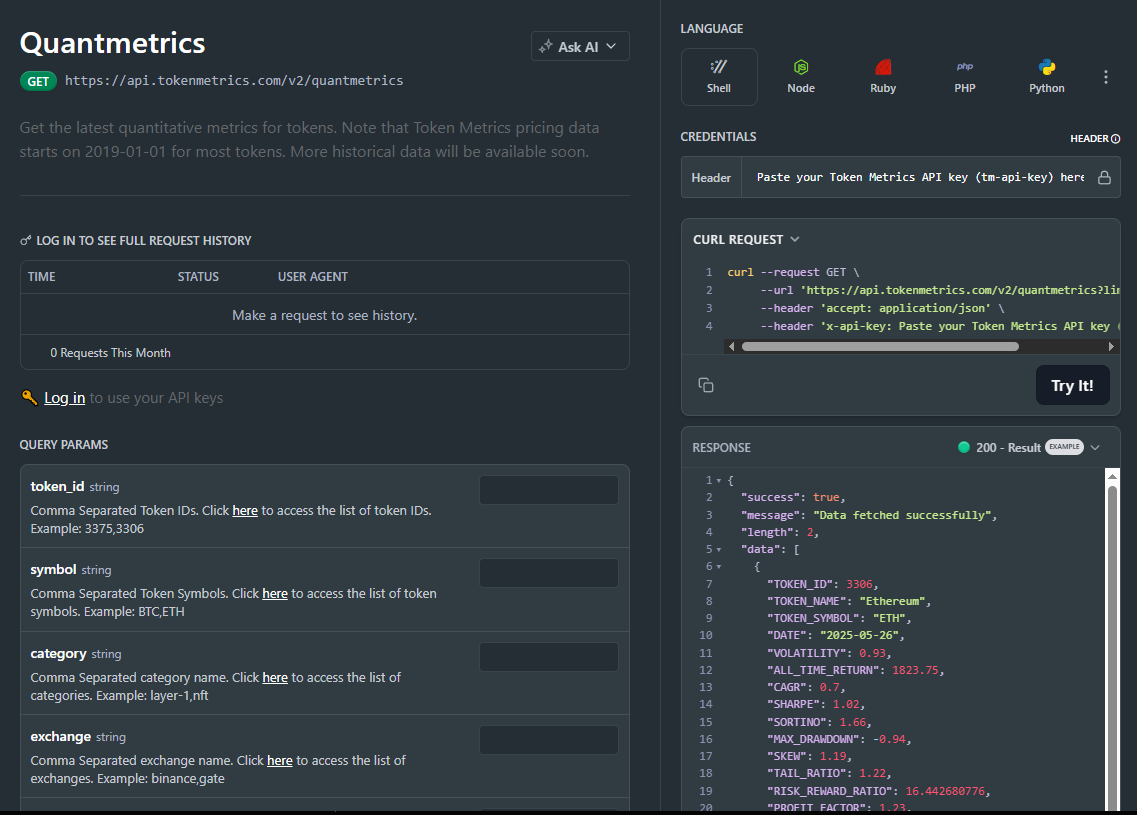
1) What does the Quantmetrics API return?
A JSON snapshot of risk-adjusted metrics (e.g., Sharpe, Sortino, volatility, max drawdown, CAGR) for a symbol and lookback window—ideal for ranking, sizing, and dashboards.
2) How fresh are the stats? What about latency/SLOs?
Responses are engineered for predictable latency. For heavy UI usage, add short-TTL caching and batch requests; for alerts, use scheduled jobs or webhooks where available.
3) Can I use Quantmetrics to size positions in a live bot?
Yes—many quants size inversely to volatility or require Sharpe ≥ X to trade. Always backtest and paper-trade before going live; past results are illustrative, not guarantees.
4) Which lookback window should I choose?
Short windows (30–90d) adapt faster but are noisier; longer windows (6–12m) are steadier but slower to react. Offer users a toggle and cache each window.
5) Do you provide SDKs or examples?
REST is straightforward (JS/Python above). Docs include quickstarts, Postman collections, and templates—start with Run Hello-TM.
6) Polling vs webhooks for quant alerts?
Dashboards usually use cached polling. For threshold alerts (e.g., Sharpe crosses 1.0), run scheduled jobs and queue notifications to keep usage smooth and idempotent.
7) Pricing, limits, and enterprise SLAs?
Begin free and scale up. See API plans for rate limits and enterprise SLA options.

%201.svg)
%201.svg)
Crypto staking is an innovative way to earn passive income from cryptocurrencies. It offers a great opportunity for cryptocurrency investors to make money without having to actively trade or mine.
In this comprehensive guide, we will discuss what crypto staking is, how it works, the different types of staking, the risks and rewards associated with it, and the best staking platforms to get started.
Whether you are a beginner or an experienced investor, this guide will provide you with the necessary information to help you make informed decisions about crypto staking. With this guide, you will be well on your way to growing your cryptocurrency portfolio in no time.
We’ve all heard of mining cryptocurrencies, but did you know there are other ways to earn coins? One of those methods is known as staking, which refers to the process of earning interest on coins held in a staking wallet or a smart contract. The interest is paid out in the form of cryptocurrencies, usually the native token of the platform you are staking your crypto on.
Staking is a low-maintenance way of earning extra coins, and it’s available to most cryptocurrencies, including the ones with a proof-of-work consensus like bitcoin. Just remember, the more popular coins, like bitcoin, have a much lower chance of generating a stake, making them less profitable than smaller alt coins and tokens.
When you stake a cryptocurrency, you’re lending your coins to the network in exchange for a percentage of the network’s new coins. Your coins are held in a staking wallet (or a smart contract), which is a designated software program designed to facilitate the staking process. The staking wallet holds your coins for you until the end of the staking period, during which time those coins are unavailable for trading.
When the staking period ends, the staking wallet sends your coins back to your wallet along with any rewards earned through staking. The amount of reward earned through staking depends on the network’s collective staking power, which is often determined by the number of coins held in the staking wallet.
Proof-of-Stake (PoS) - Proof-of-stake is a broad consensus method that doesn’t require energy-intensive mining. Instead, coins held in a wallet earn interest as a form of reward. The amount of interest earned is based on the number of coins held. PoS is used by a number of popular blockchain networks, like Ethereum.
Delegated-Proof-of-Stake (DPoS) - Delegated-proof-of-stake is a variation of proof-of-stake that allows network members to vote on delegates to manage the network. The more coins that are staked, the more voting power is available to select delegates. The delegates are responsible for validating transactions on the blockchain and receiving a cut of any transaction fees as a reward.
One potential risk is the possibility of losing access to your staked coins. If you are staking your coins on a third-party platform or through a staking pool, there is a chance that the platform could become inaccessible or go offline. This could prevent you from being able to access your staked coins or claim your rewards.
Another risk is the potential for your staked coins to be stolen. If you are staking your coins on a platform that is not secure, or if you are using an insecure wallet to store your staked coins, there is a chance that your coins could be stolen by hackers. This could result in significant losses, especially if the stolen coins are a large portion of your overall cryptocurrency holdings.
Finally, there is also the risk of volatility in the cryptocurrency market. The value of your staked coins could go up or down depending on market conditions, and this could affect the potential rewards you receive from staking. If the value of your staked coins decreases significantly, you could end up losing money even if you are earning rewards through staking.
Overall, staking cryptocurrencies can be a good way to earn rewards and help secure a blockchain network, but it is important to carefully consider the risks before deciding to stake your coins. It may be helpful to do some research and carefully evaluate the security and reliability of any platform or staking pool that you are considering using.
Here are a few tips and tricks for you to ensure a successful crypto-staking trajectory:
Staking is an excellent way to earn passive income from cryptocurrencies, especially for those who want to earn income without trading or mining. The more coins that are staked, the more rewards are earned through staking.

%201.svg)
%201.svg)
Non-Fungible Tokens, or NFTs, have exploded in popularity in recent years, with many people looking to invest in or collect these unique crypto tokens. However, not all NFTs are created equal – some are more valuable than others. One key factor that determines the value of an NFT is rarity. In this article, we will explore what NFT rarity is, how it works, and how to determine the rarity of an NFT. By understanding these concepts, investors can make more informed decisions when it comes to buying and selling NFTs.
Non-Fungible Tokens (NFTs) are a type of cryptocurrency token, like Bitcoin or Dogecoin. However, what sets NFTs apart from other crypto tokens is their "non-fungibility," meaning that they cannot be mutually exchanged. In other words, every NFT is unique and has its own set of properties, making them distinct from one another.
NFTs have become a popular market, with some tokens having high value compared to others. This has led to a surge in interest in NFTs, with many people wanting to invest in or collect them.
One factor that determines the value of an NFT is rarity. NFT rarity refers to how common a specific NFT is within a collection. Typically, the rarer the NFT, the higher its price.
In simple words, NFT rarity refers to the uniqueness or scarcity of a non-fungible token (NFT). Each NFT is created with a unique identifier that makes it distinct from all other NFTs. However, within a collection of NFTs, there can be variations in the rarity or scarcity of the different tokens.
These variations can be based on a variety of factors such as the number of tokens in a collection, the design or artwork of the token, or the properties and attributes assigned to the token. Rarity can impact the value of an NFT, as collectors and investors may be willing to pay more for a rare or highly sought-after NFT. Additionally, NFT creators and collectors may use rarity as a way to create excitement and interest in a particular collection or token.
To understand how NFT rarity works, it's important to know that when a new NFT is minted, it has a set of unique properties, known as traits, that cannot be changed. While NFTs can share a trait, no two NFTs are typically identical in a randomized collection.
NFTs with rarer features are more likely to sell for a higher price than those with more common features. As the floor price of a collection increases, the rarer NFTs also tend to increase more in value than the average of the entire collection.
Knowing how to spot rarity beforehand can give investors an advantage when it comes to NFT collecting. This can save them time and money, and give them an edge over other traders in the marketplace with information about the value trajectory of a specific type of NFT over time.
There are a few different ways to determine the rarity of an NFT. One way is to use NFT Rarity sites like Rarity Tools. This can help you find if an NFT is rare and in high demand.
Another option is to use a Rarity Ranks Extension, such as the Rarity Ranks extension. However, installing extensions may be risky and steal your confidential data.
Another way to determine NFT rarity is to use a tool like OpenSea, which allows users to create, buy, and sell NFTs. By viewing an entire collection when clicking on an NFT, users can get a sense of the rarity of a specific token. The average collection size is 10,000 items, though this can vary for different projects.
Determining the rarity of an NFT (Non-Fungible Token) is an important aspect of the NFT market. It can help buyers make informed decisions about the value and potential appreciation of a particular NFT. While there are several NFT rarity checkers available, it's difficult to identify the "best" one as different checkers may use different algorithms and data sources. Some popular NFT rarity checkers include Rarity.tools and Rarity Sniper.
Rarity.tools is a widely used platform that allows users to check rarity scores for a variety of NFT collections. Rarity Sniper provides a rarity score for each NFT, along with data on its trading history and price trends. Ultimately, the best NFT rarity checker depends on individual preferences and needs.
Rarity is important in the NFT market because it can affect the value and demand for a specific token. Because each look is limited to a specific number across the collection, some are statistically harder to come by – just like a Shiny Pokémon in the Pokémon universe. An NFT with a combination of rare attributes is more likely to sell for a higher price than those with more common traits.
In conclusion, NFT rarity is a key factor in determining the value of an NFT. By understanding how to spot and assess rarity, investors can make more informed decisions when it comes to buying and selling NFTs.
Tools like the NFT Rarity App and the Rarity Ranks Extension can be helpful in determining the rarity of a specific NFT. With this knowledge, investors can make more strategic decisions about their NFT investments and potentially maximize their returns.
The information provided on this website does not constitute investment advice, financial advice, trading advice, or any other sort of advice and you should not treat any of the website's content as such.
Token Metrics does not recommend that any cryptocurrency/NFT should be bought, sold, or held by you. Do conduct your own due diligence and consult your financial advisor before making any investment decisions.

%201.svg)
%201.svg)
The most expensive NFT sale to date was Beeple's Everydays: The First 5000 Days, which sold for $69.3 million. This highlights the growing interest in NFTs and the potential for them to be used as a vehicle for sharing virtually any form of media using the blockchain.
But what is an NFT? Let's find out.
NFTs, or non-fungible tokens, are unique digital assets with blockchain-managed ownership. They are stored on a blockchain and cannot be replicated or destroyed, making them resistant to tampering. NFTs can represent a wide range of items, including game items, digital art, collectibles, event tickets, and even ownership records for physical assets.
Unlike traditional cryptocurrencies, which are interchangeable and can be easily replicated, NFTs are non-fungible, meaning they have unique qualities that make them one-of-a-kind. This is why NFTs have gained popularity in the art world, where they can be used to verify the authenticity of a digital artwork and ensure that it cannot be copied or stolen.
When someone purchases an NFT, they not only receive the artwork itself, but also a digital receipt that proves that the piece is original, unique, and authentic. This receipt is stored on the blockchain and can be easily accessed and verified by anyone who wants to confirm the ownership and authenticity of the NFT.
While it is technically possible for someone to take a screenshot of an NFT and claim that they own it, this does not give them legal ownership of the artwork. Just like taking a picture of the Mona Lisa at the Louvre does not mean that you own the painting, taking a screenshot of an NFT does not give you ownership of the artwork.
To legally own an NFT, you must purchase it using cryptocurrency and store it in a virtual showcase. This allows you to own and display your artwork in a way that is secure and verifiable, and it ensures that you are the legal owner of the NFT.
Non-fungible tokens (NFTs) are unique digital files that are stored on a blockchain. A blockchain is a decentralized, public digital ledger that records every transaction that takes place on the decentralized web. This means that the entire history of an NFT, including its creator, properties, transactions, and smart contracts, is backed by a powerful blockchain.
NFTs are different from fungible tokens, such as Bitcoin or Ethereum, which are interchangeable and store value. In contrast, NFTs store data on the blockchain, making them unique and non-replicable.
Some key characteristics of NFTs include:
To create an NFT, there are several steps that you can follow:
Once you have created your NFT, there are several things that you can do with it:
NFT minting platforms enable creators to create non-fungible tokens (NFTs) to retain more control over their creative output. These NFTs can be sold on the following secondary marketplaces:
The demand for secondary NFT sales is growing rapidly, leading to increased competition among these marketplaces. Like the early days of Web 1 and 2.0, the emergence of Web 3.0 has created an open market where these platforms must find ways to attract and retain customers.
The thriving NFT market has led to the launch of several high-value projects, including the following companies:
Blockchain technology is known for its ability to represent assets and prove ownership. NFTs take this a step further by enabling people to potentially purchase non-fungible assets like land and gold. The global market cap for gold and real estate is over $300 trillion, so even a small percentage of that being tokenized would greatly increase the total crypto market cap. Tokenized real estate offers ordinary people the opportunity to invest in real estate, which has traditionally been difficult for the average person to participate in.
NFTs also have applications in other industries. For example, Nike recently filed a patent for NFT-enabled sneakers called "CryptoKicks." In 2019, Louis Vuitton announced plans to use NFTs to track the ownership of luxury fashion items. NFTs can also be used to tokenize certifications, degrees, and licenses, as well as sensitive data like medical records. The potential for NFTs to show ownership of any non-fungible commodity, whether real or virtual, is vast.
In conclusion, the use of non-fungible tokens (NFTs) has expanded beyond digital art and collectibles to include a wide range of real and virtual assets. The ability of NFTs to represent and prove ownership offers exciting possibilities for industries such as real estate, fashion, and even healthcare. As the technology and market continue to evolve, the potential applications for NFTs are endless.

%201.svg)
%201.svg)
If you are wondering about the future of cryptocurrency, we did some digging to answer that, and more.
Cryptocurrency has gained popularity and value in recent years, with the most well-known cryptocurrency, Bitcoin, reaching an all-time high in late 2021. However, the future of the crypto market is uncertain and the subject of much debate. Some analysts predict continued growth, while others foresee a potential crash. In this article, we will explore the potential future of cryptocurrency, including potential growth, crashes, and the role of regulation. We will also discuss predictions for specific cryptocurrencies, such as Bitcoin and Ether, as well as altcoins and decentralized finance (DeFi) and autonomous organizations (DAOs).
Will cryptocurrencies take off? Understanding the potential future of the crypto market can help investors make informed decisions about their investments.
By examining the past trends and indications in the crypto market, it appears that the future of crypto holds exciting opportunities for investors. Here are some notable crypto predictions to keep an eye on in 2023:
Some analysts predict that the popularity and value of cryptocurrencies, particularly Bitcoin, will continue to rise in 2023. This could be due to increased acceptance by businesses and higher demand for Bitcoin exchange-traded funds (ETFs).
However, others believe that the crypto market is unstable and vulnerable to a crash. In 2022, Bitcoin's price fell by roughly 40% due to factors such as slowing economic growth and rising interest rates. This bearish market may continue into 2023, leading to a potential crash.
Regardless of whether the market experiences growth or a crash, it is likely that Bitcoin and other cryptocurrencies will continue to be volatile. This volatility could be mitigated by increased regulation of the crypto market, which some predict will play a more significant role in 2023.
The shift toward decentralized finance (DeFi) and autonomous organizations (DAOs) is expected to continue in 2023. DeFi aims to remove the need for middlemen in traditional financial products, while DAOs are a new type of internet community based on blockchain technology. These developments could help to increase the stability and growth of the crypto market.
Some analysts predict that Bitcoin's price will continue to rise, potentially reaching $100,000 by the end of the year. Others believe that the market is unstable and could experience a crash.
It is predicted that over 500 million people worldwide will invest in and own Bitcoin by the end of 2023. This could be due to increased awareness and acceptance of the cryptocurrency.
The approval of the first spot Bitcoin ETF in the US is possible in 2023. This would allow investors to have direct exposure to the cryptocurrency itself, rather than just tracking Bitcoin futures contracts.
The shift toward DeFi and DAOs is expected to continue and could become the highest growth areas of the crypto market.
Some analysts predict that Ether, the second-largest cryptocurrency by market value, will outperform Bitcoin again in 2023.
It is possible that regulation of the crypto market will play a more significant role in 2023, potentially helping to stabilize the market.
The performance of altcoins, or alternative cryptocurrencies, is uncertain. Some may experience growth, while others could struggle. It is important for investors to carefully research and evaluate individual altcoins before making any investments.
When we see crypto from the growth perspective, there is a fair chance of getting the climb in 2023, especially for Bitcoin. However, Ether can take over the throne owing to the stats of 2022.
If you are seeking expert research and analysis to inform your investment decisions, consider signing up for Token Metrics. Our platform can provide you with access to the best performing cryptocurrencies with just a click. Explore our plans to learn more.

%201.svg)
%201.svg)
In this article, we will explain what crypto burning is, how it is done, and why it is done. We will also discuss the potential benefits and risks of burning crypto, as well as the role of developers and miners in the process. By the end of this article, you will have a better understanding of how crypto burning works and whether it is something that you may want to consider for your own crypto investments.
Crypto burning is the process of removing cryptocurrency from the blockchain. This concept originated from traditional stock markets and is facilitated by smart contracts. When tokens are burned, it can increase the value of the asset and make it more attractive to investors. It can also have benefits for tax regulations.
The process of burning involves sending tokens to an invalid wallet address, where they cannot be accessed. This is typically done by developers or miners to manipulate the supply of tokens and potentially increase their value.
Developers burn tokens for many reasons, including to increase the value of the asset, create hype, and improve the business model. By decreasing the supply of tokens in circulation, they can also help to combat the effects of inflation and make the market more stable.
Technically, anyone can burn crypto. However, it is not advisable for individual investors to burn their own tokens as the coins will be permanently lost. Instead, they may want to consider staking or trading their crypto.
Crypto buyback is the process of repurchasing tokens from circulation. This is typically done by developers to decrease the supply of tokens and potentially increase their value. Buybacks are regulated by smart contracts, which ensures that the removed tokens will never resurface. This can be a good way for investors to encourage long-term holding (HODLing) of the tokens.

%201.svg)
%201.svg)
In today's world of decentralization and blockchain technology, creating your own cryptocurrency has become a viable option for individuals and businesses alike. But how exactly does one go about creating a cryptocurrency? In this post, we will explore three methods for creating a cryptocurrency, ranging from the most difficult to the easiest. Whether you want to create your own blockchain, fork an existing one, or launch a token on an existing platform, this guide will provide a comprehensive overview of the steps involved. Let's dive in!
We are going to explain three ways to create a cryptocurrency, from basic to advanced.
A coin and a token are both types of cryptocurrency, but they have some key differences. A coin is a cryptocurrency that runs on its own blockchain, meaning it has its own independent infrastructure and user base. Examples of coins include Bitcoin and Litecoin.
On the other hand, a token is a cryptocurrency that is built on top of an existing blockchain, using the infrastructure and user base of that blockchain. Tokens are often created to represent a specific asset or utility, such as rewards points or event tickets. Examples of tokens include Tether and Shiba Inu.
Another key difference between coins and tokens is their relative scarcity. Since there can only be one coin on a given blockchain, the supply of coins is limited. This can give coins a certain level of value and scarcity, which can make them attractive to investors. In contrast, there can be an unlimited number of tokens on a given blockchain, which can make them less scarce and potentially less valuable.
It's important to understand the differences between coins and tokens when creating your own cryptocurrency. Depending on your goals and requirements, you may decide to create a coin or a token, or even both. With a clear understanding of the differences between the two, you can make an informed decision and choose the right approach for your project.
There are several important things to consider before designing your crypto coin. These considerations will help you make informed decisions and increase the chances of success for your project.
First, you should consider the utility of your cryptocurrency. What value does it offer to users? Why would someone want to buy and use your cryptocurrency? What problems does it solve? Answering these questions will help you understand the potential value of your cryptocurrency and determine its utility.
Second, you should consider any regulatory and legal requirements. Cryptocurrency is a rapidly evolving field, and laws and regulations can change quickly. It's important to understand any compliance issues in your area and make sure your project adheres to all relevant regulations.
Third, you should consider the tokenomics of your cryptocurrency. Tokenomics is the study of the economics of a crypto project, including factors such as initial pricing, supply, emissions, distribution, market capitalization, and potential value. Understanding the tokenomics of your project will help you make informed decisions about how to structure your cryptocurrency and maximize its potential value.
Overall, it's important to carefully consider these factors before designing your crypto coin. By taking the time to understand your goals, requirements, and the economics of your project, you can increase the chances of success for your cryptocurrency.

%201.svg)
%201.svg)
In the world of cryptocurrency, the terms "bullish" and "bearish" are commonly used to describe an investor's confidence in the potential growth of a particular crypto asset. But what do these terms really mean, and how do they apply to the crypto market? In this article, we will provide a comprehensive explanation of these terms, including the concept of a "bull run" and how it applies to both cryptocurrencies and non-fungible tokens (NFTs).
The terms "bullish" and "bearish" are commonly used in the financial market to describe the confidence an investor has in the potential growth of a financial asset. In the context of the crypto market, a "bullish" investor is one who believes that a particular cryptocurrency or non-fungible token (NFT) will rise in value. This confidence is often seen when the market is experiencing growth and gains are being made.
A "bull run" in the crypto market is a period of time during which there is high demand for cryptocurrencies and NFTs, leading to an increase in prices. This increase is driven by confidence in the market, as investors are more likely to buy when they believe prices will continue to rise. A bull run typically includes an increase in the value of well-known cryptocurrencies such as Bitcoin, Ethereum, Binance, and Solana, as these have the highest market capitalizations.
The concept of a "bull market" also applies to the market for non-fungible tokens (NFTs). In this context, a bull market is characterized by high demand for NFTs, which drives up their prices. Factors that can lead to increased demand for NFTs include strong marketing and community support from the development team, as well as the utility and scarcity of the NFTs. A collector, trader, or creator may feel bullish about a particular NFT project if they believe it has strong potential for growth. This bullish sentiment can lead to higher prices for the NFTs and a decrease in market supply.
It is important for investors to understand the terminology used in the crypto market in order to make informed decisions about their investments. The terms "bullish" and "bearish" are commonly used to describe confidence in the potential growth of a crypto asset. A "bull run" is a period of time during which there is high demand for cryptocurrencies and NFTs, leading to an increase in prices. In the NFT space, a bull market is characterized by high demand for NFTs, which drives up their prices.

%201.svg)
%201.svg)
You may have heard of CryptoPunks, Bored Ape Yacht Club, and VeeFriends, but you may not understand what they are. These names may sound like random combinations of words, but they actually represent some of the most valuable non-fungible token (NFT) projects that have emerged in the past few years.
The world of crypto art and NFTs may appear complex and mysterious, with a mix of celebrities, influencers, and internet experts. But it's not as confusing as it seems. Let's start from the beginning.
Nearly all crypto art that has been introduced to the market has been done so through the minting of non-fungible tokens (NFTs). NFTs are digital assets that have verified proof of ownership. While "fungible tokens" like the US dollar can be easily traded (like exchanging 4 quarters for a dollar), each NFT is unique and cannot be easily traded. For example, imagine a sketch of "Starry Night" by Vincent Van Gogh that has been authenticated by a fine art appraiser as an original. This sketch would be non-fungible because you could not easily exchange it for, say, an original sketch by Leonardo da Vinci. This concept is easy to understand with tangible items like art pieces or collectible cards, but when digital assets can range from a celebrity tweet to an iconic meme to a picture of a pimped out animated ape, it may be confusing.
This is where NFTs enter the scene. Say you are a graphic design artist who just finished your newest 1-of-1 piece of work and you want to sell it as an NFT. Whoever purchases this piece would not only receive the artwork but they would also receive a “digital receipt” that proves that this exact piece is original, unique and authentic.
This is the first question that many have mockingly asked on social media and internet forums. The easy answer: yes, you can screenshot practically all digital artwork, but no, that does not mean you own it.
For example, millions of people swarm into the Louvre every year, waiting patiently amidst a giddy crowd, just to capture a picture of the priceless Mona Lisa. Obviously, a picture of the Mona Lisa saved on your iPhone camera roll does not mean that you own that painting.
NFTs work the same way.
Just as the Louvre paid millions of dollars to own, maintain, and display the Mona Lisa in their museum, NFT buyers do the same. However, the main difference is that instead of paying dollars to house the art in a fancy museum, they are paying with cryptocurrency and housing their art in a virtual showcase, so to speak.
This is the basis for how NFTs, cryptocurrency, and blockchain technology are establishing a new and lucrative market for digital art and artists.
In a 2021 interview, Gary Vaynerchuk (founder of Vayner Media and creator of VeeFriends) made the following statement regarding NFTs. The interviewer remarks on the tangibility of NFTs stating, "the digital aspect, like, you can't see it" — Gary jumps in:
"Well, you can't see a blue check on Instagram? I don't walk around the world with a blue check tattooed on my forehead, but everybody sees it. You can't see my 9 million followers on Instagram, or can you? I would argue the reverse. I would argue that people can't see most of the fancy things you have in your house; that people can see more digital than real life."
And he's onto something, and I'd like to call that something "The Art of Being Digital". In our highly digitized world, our online outreach and interconnectivity is wildly amplified. Gary Vee currently has 9.9 million followers on Instagram — but without access to the internet — he has no way of interacting with that community and tapping into the true power of those 9.9 million people.
The value of an NFT is determined by the collective intentionality of those who are willing to buy and sell them. In other words, the value of an NFT is based on what people are willing to pay for it. This is similar to the way that the value of traditional art is determined by the market, with the value being based on factors such as the artist's fame and the rarity of the work.
The Tom Brady example illustrates this idea. On the surface, it might seem strange that someone would pay $430k for a digital picture of a cartoon ape. However, if we consider the fact that the buyer was Tom Brady and the seller was the well-known digital artist Trevor Jones, it becomes clearer that the value of the NFT was determined by the collective intentionality of those involved in the transaction.
Furthermore, the digital art of NFTs offers more than just a digital file and a high price tag. NFTs provide the ability for digital artists to monetize their work and for collectors to own and trade unique digital items. This opens up new opportunities for artists and collectors alike, and has led to the growth of a vibrant and exciting market for NFTs.
Celebrities such as Tom Brady, Post Malone, Steph Curry, and Jimmy Fallon have been buying Bored Ape NFTs. Bored Ape NFTs were introduced by the Bored Ape Yacht Club (BAYC) in April 2021 at a price of 0.08 Ethereum (ETH) each, or about $190 at the time. Since then, the price of Bored Apes has increased significantly, yielding substantial returns for early investors.
In addition to the potential for financial gain, buying a Bored Ape NFT also grants the buyer access to the BAYC community. This includes access to the BAYC Discord, where buyers can connect with other members of the club, including celebrities, and collaborate on NFT-related projects. BAYC also gives members priority access to future NFT drops, allowing them to expand their collections.
Minting and selling NFTs can also be highly lucrative for those who create their own NFT projects. This is another reason why celebrities and others may be interested in the NFT market. Creating and selling NFTs allows artists and other creators to monetize their digital work and gives collectors the opportunity to own unique digital items. The growth of the NFT market has created new opportunities for both artists and collectors, leading to a vibrant and exciting market for NFTs.
Blockchain technology is used to record the conversion of traditional currency into cryptocurrency, such as Ethereum (ETH), in the NFT market. This transaction is recorded on the blockchain as public information that is easily accessible to anyone who wants to view it. This ensures transparency and helps to prevent fraud in the NFT market.
Smart contracts are programs stored on the blockchain that allow NFT creators to stipulate the conditions of resale. For example, a creator could draft a smart contract that allows them to earn a 10% commission on any subsequent resales of their NFT. This allows creators to continue to benefit from the success of their work, even after the initial sale.
Smart contracts also facilitate secondary sales in the NFT market. When the value of an NFT increases, the smart contract associated with that NFT can automatically distribute any profits from the sale to the relevant parties, such as the creator or the NFT platform. For example, if the value of Tom Brady's Bored Ape NFT increased from $430k to $530k, the smart contract could automatically distribute the $100k profit to the Bored Ape Yacht Club, if that was stipulated in the contract.
This use of smart contracts helps to ensure that all parties are fairly compensated for their contributions to the NFT market, and it allows for efficient and transparent transactions without the need for intermediaries.
Grammy-winning artist Tyler, the Creator recently questioned the value of NFTs, stating that most of the examples he has seen are not "beautiful art." While art is subjective and many NFTs are AI-generated, there are still many ways in which NFTs can offer value in the real world.
First, NFTs can be used to represent tangible experiences and achievements. Instead of framing a concert ticket or a season pass, these items could be represented as NFTs, allowing individuals to proudly display their experiences and achievements in the digital world. This could be especially beneficial for VIP experiences and exclusive memberships.
Second, NFTs can provide a level of authenticity and scarcity that cannot be achieved with physical items. This is especially useful for limited edition items and collectibles, which can be authenticated and traded easily on the blockchain.
Third, the use of smart contracts can ensure that all parties are fairly compensated for their contributions to the NFT market. This allows for transparent and efficient transactions without the need for intermediaries.
Overall, while some may dismiss NFTs as "silly little digital artworks," they have the potential to reshape not just the art world, but the world itself.

%201.svg)
%201.svg)
If you are wondering what is WETH, short for Wrapped Ethereum, this is the place to be.
Cryptocurrencies have gained a lot of popularity in recent years, with many investors looking to invest in the digital assets. However, the use of these cryptocurrencies on decentralized applications (dApps) can be limited due to compatibility issues. This is where wrapped tokens come in. Wrapped tokens are tokenized versions of cryptocurrencies that can be pegged to the value of the original coin and used on different blockchain networks. In this article, we will explain what WETH is and how it works.
WETH is the abbreviation for Wrapped Ether, which is a tokenized version of the cryptocurrency Ether (ETH) that is pegged to its value. This means that the value of WETH remains the same as ETH, but it allows for increased interoperability between Ethereum and other blockchain networks.
In order to create Wrapped Ethereum, a custodian must hold the collateral (in this case, ETH). This custodian can be a merchant, multi-signature wallet, or a smart contract. To create WETH, an investor sends their ETH to the custodian, and in return, a wrapped version of the ETH is created. This process is similar to how stablecoins are created, as they are essentially "wrapped USD" that can be redeemed for fiat dollars at any time.
Wrapped tokens like WETH allow investors to hold onto their ETH while using it on other blockchain networks. This increases liquidity and capital efficiency, as investors can wrap their assets and deploy them on other chains. Wrapping Ether can also reduce transaction times and fees, as Ethereum often suffers from high gas fees. However, using wrapped tokens also means relying on a custodian and taking on additional risks.
Yes, ETH and WETH are different. ETH is the original cryptocurrency, while WETH is a wrapped version of ETH that is ERC-20 compatible. This means that it can be easily used on a wide range of decentralized applications (dApps), but it is equivalent to ETH in terms of value. Investors may need to convert their ETH to WETH in order to use certain dApps.


 Create Your Free Account
Create Your Free Account9450 SW Gemini Dr
PMB 59348
Beaverton, Oregon 97008-7105 US
.svg)




.png)
Token Metrics Media LLC is a regular publication of information, analysis, and commentary focused especially on blockchain technology and business, cryptocurrency, blockchain-based tokens, market trends, and trading strategies.
Token Metrics Media LLC does not provide individually tailored investment advice and does not take a subscriber’s or anyone’s personal circumstances into consideration when discussing investments; nor is Token Metrics Advisers LLC registered as an investment adviser or broker-dealer in any jurisdiction.
Information contained herein is not an offer or solicitation to buy, hold, or sell any security. The Token Metrics team has advised and invested in many blockchain companies. A complete list of their advisory roles and current holdings can be viewed here: https://tokenmetrics.com/disclosures.html/
Token Metrics Media LLC relies on information from various sources believed to be reliable, including clients and third parties, but cannot guarantee the accuracy and completeness of that information. Additionally, Token Metrics Media LLC does not provide tax advice, and investors are encouraged to consult with their personal tax advisors.
All investing involves risk, including the possible loss of money you invest, and past performance does not guarantee future performance. Ratings and price predictions are provided for informational and illustrative purposes, and may not reflect actual future performance.

